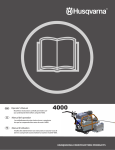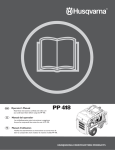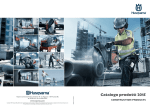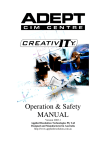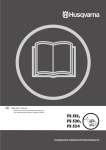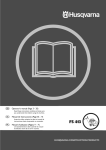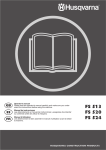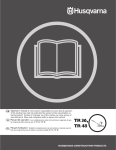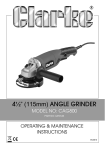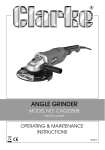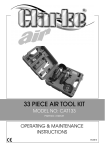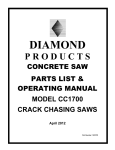Download Husqvarna 380 Lawn Mower User Manual
Transcript
Operator’s Manual Read these instructions carefully and make sure 450 you understand them before using the 450. Manual del operador Lea cuidadosamente estas instrucciones y asegúrese de que las comprende bien antes de usar el 450. Manuel d’utilisation Veuillez lire attentivement ces instructions et assurez-vous de bien les comprendre avant d’utiliser la machine modèle 450. UNPACKING CONTENTS Content Your 450 saw has been shipped from the factory thoroughly inspected. Only minimal assembly is required to start using the saw. Remove the saw from the container using proper lifting techniques. Discard or recycle the packing material per your regional laws. In your container will be the 450 saw, blade shaft wrench, an owner’s manual, an engine owner’s manual, a part list, a warranty card, a joint protector sample pack, a diamond blade, a skid plate, and a ramp for unloading the saw. Raise the saw to its full height by pressing down on the handle bar. Place the unloading ramp at the edge of the container and roll the saw out of the container. Lower the saw by pressing down on the handle bar and squeezing the lever on the handle bar. Page Table of contents ………………………….. Unpacking .................................................. Transporting ............................................... Sound Data ................................................ 2 2 2 2 Introduction, personal safety ...................... 3 Registration of the product ………………… 4 General safety message ............................ 4 Safety warnings ......................................... 5 TRANSPORTING Excel series blades ................................... 6 Blade and skid plate installation ................ 6 The 450 saw weights approximately 139 pounds (63 kilograms) when ready to use . Use safe lifting practices when handling the saw. Always remove the diamond blade when transporting the saw. Always transport the saw with a skid plate installed. Raise the guide arm to the back position. Loosen the handle locking knob and fold the handle forward. Tighten the handle locking knob and make sure the handle is locked in the keyways. The saw can be lifted from the center of the handle. If two (2) people are lifting the saw, use the handle bar and lift with two hands on each side of the saw. Always store and transport the saw in a completely lowered position and secured from moving. Lifting point Handle bar What is what? ............................................ 7 Operating instructions ............................... 8 Fuel and fuel safety warnings …….…….... Recommended fuels ................................. Recommended oils …….......……….…..… 9 9 9 Maintenance .............................................. 10 Sawing contraction joints …………....….… 11 Maximizing the Soff-Cut system .......…..... 12 Troubleshooting ......................................... 13 Handle locking knob Technical specifications ............................. 14 Conformity certificates ............................... 14 Warranty .................................................... 15 Blade release lever Lifting point CAUTION Only use the center of the handle or the handle bar when lifting the 450. SOUND DATA According to Standard ISO 3744:1998 and Directive 2000/14/ EC for environmental sound level and according to Standard ISO 11201:1995 for sound level at the operator’s position, the 450 saw emits the following: Sound power level Lwa 102 dB (A) Sound pressure level Lpa 86 dB (A) WARNING Always wear safety approved hearing protection. 2 INTRODUCTION The 450 is designed as a residential and light commercial Ultra Early Entry concrete saw. The patented Soff-Cut Ultra Early Entry dry cutting system controls random cracking of concrete through the early timing of the saw cutting usually within one to two hours after finishing process is completed. The patented low noise and low dust blade block and skid plate technology in conjunction with the Husqvarna blades allows for Ultra Early Entry sawing the same day while minimizing chipping and spalling. The saw is a manual push style with manual controls for all functions. Common sense: The focus of this manual is HOW to operate and service the equipment safely. It is not possible to cover every conceivable situation you can face when using this equipment. Therefore use this product only in a manner described in this manual. Operation or handling the machine in any other manner can lead to serious injury or death. If a situation is not described in this manual it should be considered dangerous - and not be done. If you are unfamiliar with this product make sure that you carefully understand how it functions and practice all operations and handling before putting the machine to use. Familiarize yourself in the presence of an experienced operator. Avoid all situations that are beyond your capability. If you still feel uncertain about the operating procedures after reading these instructions DO NOT operate the machine until you have consulted an experienced operator. If you have further questions you can contact the closest Husqvarna Construction Products location by writing or calling, see information below. You can also find the closest location by searching the internet at; www.husqvarnacp.com . Husqvarna Construction Products will willingly be of service and provide you with advice as well as help you to use your product both efficiently and safely. Additional manuals are available at NO CHARGE and can also be obtained on the internet site. Toll Free no: 800 776 3328 (USA & Canada) Husqvarna Construction Products Phone no: 951 272 2330 Telefax no: 951 272 2338 265 Radio Road Corona, California 92879 Internet Site: www.husqvarnacp.com USA PERSONAL SAFETY EQUIPMENT When working and operating the saw the following approved personal safety items should be used: Head Protection Hearing Protection Eye Protection 3 Safety Shoes Protective Gloves REGISTER THE PRODUCT Please register your new 450 with Husqvarna Construction Products by mailing in the registration card that came with the machine or you can register on the internet site www.husqvarnawarranty.com Registration will allow us to contact in case of any critical updates or recalls on this machine. Warranty registration has also been found to be helpful in tracing stolen equipment. Record the following information for your records: PURCHASE DATE: ________________ MODEL No: ________________ SERIAL No: __________________ ENGINE MODEL: _____________ ENGINE TYPE: ______________ ENGINE CODE: ________________ The 450 model and serial number as well as the engine model number, engine type and code are critical in order to obtain the correct service parts. SAFETY DEFINITIONS In this manual a Safety Alert Symbol followed by the signal words WARNING and CAUTION are used to identify safety information about hazards which can result in death, serious injury and/or property damage. These signal words mean: WARNING indicates a hazard which, if not avoided, could result in death or serious injury. CAUTION indicates a hazard which, if not avoided, might result in minor or moderate injury. NOTICE indicates a message not related to personal injury. SAFETY HAZARDS WARNING DO NOT MODIFY THE PRODUCT Under no circumstances may the design of the machine be modified without the permission of the manufacturer. Always use genuine accessories. Unauthorized modifications and/or accessories can result in serious personal injury or the death of the operator or others. Your warranty may not cover damage or liability caused by the use of unauthorized accessories or replacement parts. WARNING WARNING CAUTION ASPHYXIATION HAZARD Running an engine in a confined or badly ventilated area can result in injury or death due to asphyxiation or carbon monoxide poisoning. CALIFORNIA PROP 65 Use of this product can expose you to materials known to the State of California to cause cancer and/or birth defects or other reproductive harm. HEARING HAZARD During the normal use of this machine, operator may be exposed to a noise level equal to or higher than 85 dB(A). Use hearing protection. 4 SAFETY WARNINGS SAW SAFETY WARNING • Do not leave saw unattended while the engine is running. Failure to comply with the following warnings could result in serious bodily injury or death! • Do not alter the saw. Any alteration or modification is misuse and may result in a dangerous condition. • All safety guards must be in place before starting the engine. PERSONAL SAFETY • Read and understand instructions before operating saw. • Only operate the saw from behind the machine with both hands on the handle. • Always wear safety approved hearing, eye, head and respiratory protection. • Wear boots with non-slip soles to provide proper footing. Steel-toed safety boots are recommended. • Do not use damaged equipment, blades, guards or personal protection equipment. Do not disable safety equipment or kill switches. • Do not operate the saw if there is a fuel leak. • Wear rubber work gloves to avoid contact with wet concrete which can cause serious skin irritation. • Use extreme caution when maneuvering the saw on ramps or loading and unloading from trucks or trailers. • Know how to stop the saw quickly in case of emergency. • Keep all parts of your body away from blade and other moving parts. Do not wear loose clothing or jewelry which can be caught in moving parts. Wear protective hair covering to contain long hair. • Use caution when loading and unloading saw. • Use only Husqvarna Construction Products replacement parts. Use of unauthorized parts may create a danger. • Do not use the saw as vehicle for transporting personnel or equipment. • Remove the ignition cable from the spark plug before performing saw maintenance or changing blades to prevent accidental engine starting. • Stay alert. Maintain awareness of saw operation. Use common sense. Do not operate saw when tired or after consumption of any substance that would impair physical function or rational judgment. • Remove all wrenches from the saw before starting. • Never stand on the saw. • Do not over reach. Keep proper footing and balance. • When the saw is not in use or transporting, remove the blade and lower the saw completely. Properly secure the saw to prevent accidental movement. WORK AREA SAFETY • Never operate the saw in any application or job where you are not trained or supervised. BLADE SAFETY • Keep visitors, children and animals out of the work area. • Examine cutting blades before each use. Do not use any blades that has cracks, nicks, or flaws. Tri-arbor hole should be undamaged. Use only dry cut, steel centered, tri-arbor diamond blades made for cutting green concrete. • Observe all safety regulations for the safe handling of fuel. Gasoline is extremely flammable and its vapors can explode if ignited. Do not refuel indoors or in poorly ventilated areas. Handle fuel in safety containers. Shut off the engine and allow it to cool before refueling. Wipe the saw dry if fuel is spilled on it. Always move away from the fueling area before starting the engine. Do not smoke while refueling. • Husqvarna Excel Series diamond blades are designed to only cut green concrete. Cutting any other material may result in blade failure or a dangerous condition. • Inspect blade flanges for damage, excessive wear and cleanliness before mounting the blade. The blade should fit snugly on clean, undamaged, tri-arbor shaft. • Do not operate the saw while smoking or near an open flame. • Do not operate the saw in areas of combustible material or fumes. Sparks may occur from the saw that could cause a fire or explosion. • Use only Husqvarna Excel Series blades or blades marked with a maximum operating speed greater than 3200 rpm. • Operate only in well ventilated areas. Engine exhaust contain • Never operate the saw without the blade block assembly carbon monoxide which can cause loss of consciousness and securely in place including blade cover, lexan shields and possible death. skid plate installed in working order. A damaged blade block assembly must be replaced to protect the operator. • The muffler and engine become very hot during operation. Keep all body parts and foreign material away from the • Make sure the blade does not make contact with the ground engine while running. or any other surface when maneuvering the saw. • Avoid dangerous environments. Do not expose saw to rain. Keep work area well lit and clean. • Avoid getting in direct line with the blade or contacting the blade while it is rotating. 5 EXCEL SERIES BLADES The Excel Series of diamond blades have been designed specifically for the Soff-Cut Ultra Early Entry dry cutting system of green concrete. These specialty blades are designed to increase speed and life while cutting a wide range of aggregates. Choose the correct specification of diamond blade for your area as follows: Purple Excel Series 1000 XL8-1000 Ultra hard aggregate and non abrasive sand Green Excel Series 2000 XL8-2000 Hard to ultra hard aggregate and non abrasive sand Red Excel Series 3000 XL8-3000 Hard aggregate, medium abrasive sand Orange Excel Series 4000 XL8-4000 Medium hard aggregate, medium abrasive sand Yellow Excel Series 5000 XL8-5000 Medium hard to soft aggregate, abrasive sand Black Excel Series 6000 XL8-6000 Soft aggregate, highly abrasive sand BLADE AND SKID PLATE INSTALLATION Step 1 With the saw turned off, unfold the handle to its full upright position and tighten the locking knob. With both hands, push down on the handle bar and raise the to its full height and locked position. Step 2 Remove the blade block cover (A) by turning the two locking knobs counter-clockwise. Insert the blade wrench supplied with the saw on the blade shaft bolt (B) on the end of the blade shaft in the blade block (C). Rotate the blade shaft counterclockwise with the wrench on the blade shaft bolt (B) while pushing in on the blade shaft locking pin (D) located on the front of the saw frame. The locking pin will drop down in the blade shaft and prevent the shaft from rotating. Step 3 Remove the blade shaft bolt by continuing to turn the bolt counter-clockwise. Remove the outer arbor washer or flange (E). Step 5 Install a new skid plate (G) by hooking the front on the front blade block shaft pin. Connect the rear blade block shaft and the rear of the skid plate by installing the locking pin (H). Step 6 Install the blade cover by turning the two knobs and tighten until fully seated against the blade block. Lift the front and rear of the skid plate to insure the blade slides through the skid plate freely. Step 7 Insure the lexan shields (I & J) move freely up and down. When replacing a worn blade, thoroughly clean the concrete from blade block and blade cover before installing the new blade. Discard the old skid plate and replace it with a new skid plate. WARNING NOTE: The patented skid plate is the most important part of the Soff-Cut Ultra Early Entry system. If it is bent, twisted or damaged, spalling and raveling of a cut may result. Store skid plates carefully and install them properly. Install a new skid plate with each new blade. Never re-use skid plates. Inspect the blade (K) for any damage. Do not use any blade that has cracks, nicks, flaws or a damaged arbor. Make sure the blade is marked with a maximum operating speed greater than 3200 rpm. A Step 4 Match the blade tri-arbor to the blade shaft arbor (F) and install the blade firmly against the rear flange (F). Insure the blade is installed on the tri-arbor correctly. Match the female tri-arbor of the outer washer or flange with the blade shaft and install the blade shaft bolt turning clockwise while holding the locking pin in. Be sure the outer flange is fully seated and firmly holding the diamond blade in position. K E D H F J C B G I 6 WHAT IS WHAT Model number and serial number G F E D B C A F What is what? A. B. C. D. E. F. G. H. I. J. K. L. M. N. O. P. Q. Oil fill & dipstick Air cleaner Fuel shut off lever Fuel tank Oil drain hose Engine choke Hour meter/Tachometer Hood Engine on/off switch Front guide Rear guide Recoil starter Handle locking knob Engine throttle control Guide arm lever Blade depth release lever Handle bar H N G L M O P Q 7 I J K OPERATING INSTRUCTIONS Handle bar Blade release lever Hood To start the engine, turn the fuel valve (C) on by the carburetor on the side of the engine. Raise the saw by pushing down on the handle bar (Q) with both hands to the full locked position. Push the engine kill switch (I) to the “ON” or “1” position. Push the engine throttle control (N) 1/3 of the way. Close the engine choke by pulling the engine choke knob (F). The closed choke position enriches the fuel mixture for starting a cold engine. The open choke position provides the correct fuel mixture for operation after the engine starts and for restarting a warm engine. Start the engine by pulling the rope handle (L) on the back of the saw. After the engine starts, slowly open the choke by pushing the engine choke knob (F). Allow the engine to warm for a few minutes. Open the engine throttle lever (N) to full open position for maximum engine speed shown on the tachometer (G). Lower the front guide (J) to the full down position by pushing the front guide control lever (O) forward. Rear guide Blade block Front guide wheel Experience is very important when running the 450 saw. A skilled worker is highly recommended. Always do an inspection of the saw before starting the engine. Open the hood (H) and check the fuel (D) and oil level (A) per the enclosed engine manual. SAE 10W/30 oil and unleaded gasoline with an 87 or higher octane should be used. Observe all safety regulations for the safe handling of fuel. Always check the engine oil with the saw turned off, completely lowered and the engine level! Check that all controls are in good working order. Check for loose bolts or nuts. Check for fuel or oil leaks. WARNING Do not operate saw if there is a fuel leak! Insure all guards are secure, undamaged and properly installed. WARNING Do not operate the saw unless all guards, safety equipment and the engine kill switch are in place and operational! Check the air filter (B) and clean or replace if necessary. Check for proper specification of blade and that the skid plate operates properly. Check that the blade and skid plate are in good condition. Check that the handle is in the full upright and locked position and the handle locking knob (M) is tight. Make sure the work site is clean, well lit and hazard free. WARNING ASPHYXIATION HAZARD Running an engine in a confined or badly ventilated area can result in injury or death due to asphyxiation or carbon monoxide poisoning. Line up the saw with the cut line using the front guide wheel, the rear guide (K) and the triangle pointer on the back of the blade block. Push down on the saw handle and pull the blade release lever (P) to lower the blade in the concrete slowly. Push the saw forward to cut keeping the front guide wheel on the cut line. Push the saw at about half speed for the first 50 feet to allow the blade to develop good diamond exposure or open up and promote blade life. Increase the forward speed of the saw until the blade and the engine are working at maximum efficiency. Do not force the saw. When approaching a wall, raise the front guide and use the triangle guide at the back of the blade block and the rear guide on the wheel (K) to cut the last few feet. Do not hit the blade block assembly against any object. Damage may result. Push down on the back of the handle bar to raise the saw out of the cut to the full and locked position. Move the engine throttle lever to the full closed position. Turn the engine kill switch to the “OFF” or “0” position. WARNING Do not leave the saw unattended while the engine is running! Always secure the saw from movement while unattended. Periodically, clean any excess concrete from inside the blade block, scrappers and blade cover. Always clean the blade block assembly thoroughly before storing the saw. Always close fuel valve before transporting. Do not walk on the joints or transport equipment across the joints until the concrete fully hardens. WARNING Before each use, carefully inspect the 450 for any damage to any of its parts and components. Pay careful attention to any leakage of gasoline or oil. Under no circumstance should the 450 or any of its attachments be operated if you find damage or are suspicious that something appears to be damaged. 8 FUEL HANDLING OIL HANDLING WARNING NOTICE Used oil is a hazardous waste product. Dispose of used oil properly. Do not discard with household waste. Check with your local authorities, service center, or dealer for safe disposal/recycling facility. Taking the following precautions will lessen the risk of injury and property damage: - Use extreme care in handling gasoline. It is extremely flammable and the vapors are explosive. - Extinguish all cigarettes, cigars, pipes, and other sources of ignition. - Use only approved gasoline containers. - Never remove gas cap or add fuel with the engine running. Allow engine to cool a minimum of 3 minutes before refueling. - Never fuel the machine indoors. - Never store the machine or fuel container where there is an open flame, spark, or pilot light such as on a water heater or other appliances. - Never fill containers inside a vehicle or on a truck or trailer bed with a plastic liner. Always place containers on the ground away from your vehicle when filling. - Remove the 450 from the truck or trailer and refuel it on the ground. If this is not possible, then refuel the equipment with a portable container, rather than from a gasoline dispenser nozzle. - Keep the nozzle in contact with the rim of the fuel tank or container opening at all times until fueling is complete. Do not use a nozzle lock-open device. - If fuel is spilled on clothing, change clothing immediately. - Never overfill fuel tank. Always wipe off any spilled fuel or oil. Replace fuel cap and tighten ENGINE OIL Oil Recommendation The engine holds approximately 0.6 quart (0.6 liter) when changing oil. - Use a 4-stroke automotive detergent oil of API service class SE or higher grade. - Do not use special additives. - Choose a viscosity according to the table below. Please read the enclosed Robin Operator’s Manual for complete oil information. PROPER FUEL The Robin engine is certified to operate on automotive unleaded gasoline with a pump octane rating (M+R) of 87 or higher. Fuel tank capacity is 1.0 gallon (3.6 liters). Refuel in a well-ventilated area with the engine stopped. You may use regular unleaded gasoline containing no more than 10% ethanol (E10). Do not use gasoline containing methanol. Use of fuels with an ethanol content of more than 10% (E10) may cause starting and/or performance problems. It may also damage metal, rubber, and plastic parts of the fuel system, as well as posing a fire hazard. Do not use fuel that is older than 30 days. Old fuel can cause running problems as well as fuel system damage. The engine will not operate on gasoline marketed as E-85 (85% ethanol) 9 MAINTENANCE Engine Oil Checking, Adding and Changing Oil Check the engine oil level (B) daily with saw fully lowered and the engine level. See the enclosed Robin manual for more details. Use SAE 10W-30 viscosity detergent automotive type with API service class SE or higher grade oil. Note: Engine holds approximately 0.6 quart (0.6 liter) when changing. Changing the Oil Change oil after the first 5 to 8 hours of use. Thereafter every 50 hours. A C Guards Check all guards for damage and proper function daily especially the blade block. Blade block and cover should be secure to the saw and not damaged. Lexan side covers on the blade block should move freely up and down. Diamond blade Inspect diamond blades daily for damage, cracks, secure fit to the arbor, loss of segments, warping or overheating. If any blade shows any of these problems, discard the blade and never use. Skid plate Inspect the skid plate daily for damage, excessive wear in the blade slot, burrs on the concrete surface side, twisting and free movement up and down when installed on the blade block. Replace the skid plate with each new diamond blade. Never reuse the skid plates or spalling and raveling may result. Saw controls Inspect all controls for proper function daily. Check all the interlocks for operation especially the engine on/off switch for proper operation. Belt Inspect the blade drive belt for cracks or signs of wear. The belt tension is controlled by belt tensioner and does not require adjustment. Inspect the belt tensioner for free movement up and down. Insure the belt tensioner bearings roll freely. Blade shaft bearings Lubricate the blade shaft bearings with 3 pumps of Lithium 12 based grease every 50 hours. B The oil drain hose (A) is located at the rear of the saw. 1. With the engine OFF but still warm, remove the brass cap and drain the oil in a pan. 2. Replace the brass cap on the oil drain hose. 3. Fill the engine at the oil fill cap (B) with 0.6 quart (0.6 liter) of oil. When full, the oil level should be at the high level mark on the dipstick or to the top of the threads on the engine fill hole. The engine is equipped with an oil alert system that will stop the engine if the oil level is low. NOTICE Used oil is a hazardous waste product. Dispose of used oil properly. Do not discard with household waste. Check with your local authorities, service center, or dealer for safe disposal/recycling facility. Air filter The air cleaner assembly (C) is a cyclone type that can be accessed from the hood on the saw. The air cleaner element should be replaced every 50 hours. Refer to the supplied engine manual and the “Cyclone Dual-Filter-Element Type” for additional information. ADDITIONAL ENGINE INFORMATION Please see the Robin Operator’s Manual for additional information about servicing the engine. The manual also has specific information about specifications, tune-up parts, engine warranty, emission compliance, etc. Cleaning Clean the blade block of any excess concrete build up after each use. Keep the handle bar and controls clean and dry. Immediately clean any spilled fuel from the saw. Keep all openings and slot on the engine shrouding on the saw clean and open so air flows freely through the engine to insure proper cooling. MAINTENANCE SCHEDULE Check guarding, diamond blade, Daily skid plate, lexan covers, controls and oil levels. Clean blade block assembly and saw. Daily Replace air cleaner. Every 50 hours Replace engine oil. Every 50 hours Grease blade shaft bearings. Every 50 hours Check blade drive belt and belt tensioner. Every 50 hours WARNING Do not modify the saw! Use only Husqvarna Construction Products replacement parts. Use of unauthorized parts may create a danger or damage the engine. 10 SAWING CONTRACTION JOINTS As concrete hydrates or cures and begins to set, it develops internal stresses which may cause random cracks. Random cracks cast doubt on the quality and workmanship of the concrete. Contraction joints are cut in concrete to relieve these stresses before they seek their own relief in the form of random crack. The Soff-Cut Ultra Early Entry system controls random cracking through the early timing of a saw cut at predetermined locations to create weakened planes in the concrete that subsequently crack at the bottom of the cut to relieve stress. Husqvarna sawed contraction joints should be a minimum of 1/8th the concrete depth and a minimum of 1” (25mm) deep. Contraction joints should be sawn as soon as the concrete will support the weight of the saw and the operator without marking or damaging the concrete. There are many possibilities for joint layout. Joint layout should be provided, the saw contractor should submit a detailed joint layout for approval prior to cutting. Several factors affect joint spacing including: • Concrete thickness • Type, amount and location of reinforcement • Shrinkage potential of concrete-cement (type, quantity), aggregate (size, quantity, quality), water to cement ratio, admixtures, concrete temperature • Base friction • Slab restraints • Layout of foundations, racks, pits, equipment pad, trenches, etc. • Environmental factors - temperature, wind, humidity • Methods and quality of concrete curing. Generally, contraction joint patterns should divide slabs into approximate square panels per the recommended spacing shown. RECOMMENDED CONTRACTION JOINT SPACING Concrete thickness, in. (mm) Maximum spacing, ft. (m) 3.5 (90) 8 (2.4) 4, 4.5 (100, 114) 10 (3.0) 5, 5.5 (125, 140) 12 (3.6) 6 (150) or greater 15 (4.5) At all intersecting cross cuts, install Husqvarna joint protectors at each joint to prevent joint damage. Install an additional joint protector where the right wheel will cross the joint to prevent concrete damage. 11 MAXIMIZING THE SOFF-CUT SYSTEM “ The timing of concrete operations - especially finishing and jointing - is critical”, states a quote from the foreword of the American Concrete Institute (ACI) 302.1 R-96. It goes on to say that “Failure to address this issue can contribute to undesirable characteristics in the wearing surface as cracking...” (It mentions other problems). The patented Soff-Cut Ultra Early Entry system has revolutionized the method used to control random cracking. While SoffCut is being specified more today than ever, sometimes the ultra early-entry spec is not always followed on the job site. In order for the Soff-Cut system and an experienced Husqvarna contractor to do a satisfactory job, four components must exist to meet the “specification”: 1. A Soff-Cut Ultra Early Entry dry up-cut saw 2. A Husqvarna Excel Series dry-cutting diamond blade 3. A Husqvarna anti-ravel skid plate installed with every new diamond blade 4. An operator skilled in using the Soff-Cut Ultra Early Entry cutting system. Without this, joints can not be cut clearly enough to control random cracking before it starts, which is what the building owner is paying for. The ACI Spec 302.1R-96 says it best: “Early-entry dry-cut saws use diamond-impregnated blades and a skid plate that helps prevent spalling. Timely changing of skid plates is necessary to effectively control spalling. It is best to change skid plates in accordance with manufacturer’s recommendations...The goal of saw-cutting is to create a weakened plane as soon as the joint can be cut...The timing of the early-entry process allows joints to be in place prior to development of significant tensile stress in the concrete...” The Portland Cement Association (PCA) engineering bulletin, Concrete Floors on the ground, also states: “Proper jointing can eliminate unsightly random cracks. Aspects of joining that lead to a good job are choosing the correct type of joint for each location, establishing a good joint pattern and layout, and installing the joint at the correct time... Timing of joint sawing is critical...Lightweight, high-speed, early-cut saws have been developed to permit the joint sawing very soon after floor finishing, sometimes within 0 to 2 hours...if the cut is sawn within a few hours after the final finishing, random cracking can be controlled...” Husqvarna has the only Ultra Early Entry dry-cutting system (Soff-Cut) which controls random cracking through the early timing of the cut. With the patented Soff-Cut method, control joints are usually cut within 0 to 2 hours after the finishing process. Joint cutting should begin as soon as the concrete will support the weight of the saw and the operator at each joint location and before final set. If the joints are not being cut within this time frame then the Soff-Cut Ultra Early Entry method is not being followed and building owners are not getting what they are paying for or the finished product that they expect. We hope this information is beneficial to building owners, general contractors, concrete finishers, saw operators and the entire industry. For additional information, contact Husqvarna Construction Products at (951) 272-2330 or (800) 776-3328, or see our website www.husqvarnacp.com. 12 TROUBLESHOOTING SAW IS SPALLING AND RAVELLING CUT - Check to see if the diamond blade is worn out, glazed, warped or damaged. ENGINE WILL NOT START - Check if the fuel valve is turned to the “on” position. - Check if there is fuel in the tank and it is the correct fuel. Make sure there is no water in the fuel. - Insure skid plate moves freely up and down the entire shaft length without contacting the diamond blade. - Check that the spark plug wires are connected to the spark plugs. - Check skid plate for excessive wear or gap around the diamond blade. - Check skid plate for tension or loose mounts. Skid plates are preset at the factory. - Check bottom of skid plate for metal burrs or irregularities. - Engine is flooded. Adjust the choke per the engine owner’s manual. - Check that the air filter is not dirty or plugged. - Check the choke is in the “on” position for cold starts. Adjust the choke per the engine owner’s manual. - Insure skid plate is not twisted or bent. - Check lexan covers for free movement up and down. - Check that the blade shaft rotates freely and no concrete has built up in the blade block. - Insure there is spring down pressure at each end of the skid plate. - Check if the kill switch is in the “ON” position. - Do not twist or move the saw sideways while cutting. - Oil level is too low. Engine is equipped with an oil alert system that will not let the engine start unless the engine oil level is within the correct range. - Check that the engine is running properly and at full throttle. - Check belt and belt idler for proper tension. SAW PULLS TO ONE SIDE WHILE SAWING - Check front and rear guide is properly aligned with the center of the diamond blade. - Insure the diamond blade is properly mounted and secured with clean flanges. - Insure that the diamond blade is the correct specification for your area. - Check to see if diamond blade is worn out, glazed, warped or damaged. - Insure the slab is in clean with no debris that could raise the skid plate or saw while cutting. - Use Husqvarna joint protectors at all cut intersections. - Do not twist or move the saw sideways while cutting. Make gradual changes in pressure on the handle bar to control the saw in the cut. - Clean excess concrete debris from the blade block assembly. - Insure that all wheels rolls freely and smoothly. - Check that the scrapers in the blade block are not bent or binding. - Do not force the saw. Allow the diamond blade to cut at its own rate of speed. - Insure that the blade block shafts are not bent or damaged. - Check the skid plate for damage or burrs. - Check that the front diverter in the blade block is not bent and the diverter legs are not contacting the concrete. ENGINE RUNS ROUGH, BACK FIRES OR CAN NOT REACH FULL SPEED - Check if there is fuel in the tank and it is the correct fuel. Make sure there is no water in the fuel. - Check that the spark plugs are clean and properly gapped. - Check that choke is in the “off” position after engine is warm. - Check that air filter is not dirty or plugged. - Check that the throttle lever is properly set. - Check for correct oil level. Engine oil alert system may function intermittently if oil level is not within the correct range. 13 TECHNICAL SPECIFICATIONS Weight and Dimensions 450 Weight – dry Weight with gasoline and oil full 132 lbs 139 lbs 60 kg 63 kg Length Width Height 34 inch 19 inch 21 inch 864 mm 483 mm 533 mm Blade Material cut Blade type Blade rotation Blade shaft speed Cutting depth Cutting distance from wall Green concrete only 8.0” (203 mm) dry cut with tri-arbor Counter clockwise, upcutting 3350 rpm 1 to 1 3/16 inch (25 to 30 mm) depending on amount of blade wear 3 inch 76 mm Average cutting rate - Estimate only. Speed will vary with job conditions and concrete mixes. Soft aggregates 13 ft/min 4.0 m/min Medium aggregates 9 ft/min 2.7 m/min Hard aggregates 5 ft/min 1.5 m/min Engine: Engine oil volume Gasoline tank volume Type Air filter Oil system Muffler Emissions Cooling Cylinder Controls Robin EX17 0.6 quart 0.6 liter 1.0 gal 3.6 liter Air cooled, 4-cycle, single slant cylinder, overhead camshaft, gasoline engine Cyclonic type Oil alert with auto shut down sensor Silent type 77 dbA, exhaust deflector, spark arrestor Complies with EPA Phase 2 and CARB Tier II USA regulations Air cooled with internal and external cooling fins Aluminum with cast iron liner Engine mounted manual throttle, choke and fuel shut off levers, manual on/off switch CONFORMITY CERTIFICATES CALIFORNIA AIR RESOURCES BOARD (CARB): This machine is considered a preempt Off-Road Application as relating to CARB standards. Under construction equipment, and in particular, as a Saws : concrete, masonry, cutoff, with engine power less than 19KW (25hp), CARB standards do not apply to this machine. For more information see the website http://www.arb.ca.gov/msprog/offroad/preempt.htm 14 WARRANTY HusqvarnA Equipment Warranty New 450 sold by Husqvarna Construction Products are warranted to be free from manufacturing defects in normal service for a period of six (6) months for labor and up to one (1) year on parts from date of purchase by the original consumer purchaser or date of introduction into rental company fleet. Our obligation under this warranty is expressly limited to the replacement or repair at Husqvarna Construction Products, or at a service facility designated by us, of such part or parts if inspection shall disclose it to have been defective. This warranty does not apply to defects caused by damage, unreasonable use, faulty repairs made by others (or defects caused by failure to provide reasonable maintenance, while in the possession of the consumer). Further, the warranty is void if the product, or any of its components, are altered or modified by the consumer purchaser, or if the product is used in an inappropriate manner not recommended by the manufacturer. The use of any other blade except Husqvarna Construction Products blades and skid plates will void the warranty and could cause internal damage to the motor. In no event shall Husqvarna Construction Products be liable for any indirect, incidental or consequential damages from the sale or use of the product. This disclaimer applies both during and after the term of this warranty. This warranty gives you specific legal rights and other possible rights, which may vary from state to state. Some states do not allow the exclusion or limitation of incidental or consequential damages so the above limitation or exclusion may not apply to you. Some states do not allow limitations on how long an implied warranty lasts so the above limitation may not apply to you. Warranty On Engine Husqvarna Construction Products does not perform warranty repairs or reimburse for warranty repairs on engines. Engine warranties are provided by the engine manufacturer. To obtain warranty repair: Take your engine along with your proof of purchase to any general purpose dealer or distributor nearest you. If you are unable to obtain warranty service or are dissatisfied with the warranty service you received, contact the owner of the dealership involved. Normally, this should resolve your problem. For further assistance, call our parts and service department at 1-800-776-3328 or 1-951-272-2330. Warranty On REPLACEMENT PARTS There is a three (3) months warranty from date of purchase on all replacement parts. Copyright 2009 HUSQVARNA construction products Covered by one or more of the following U.S. Patents 4769201, 4889675, 4928662, 4938201, 5056499, 5086750, 5184597, 5303688, 5305729, 5373834, 5441033, 5505189, 5507273, 5570677, 5575271, 5579754, 5582899, 5603310, 5660161, 5664553, 5666939, 5689072, 58030371, 6892719, 6990972, 7073495, 7163010, 7258115. Other U.S. and foreign patents pending. 15 505 41 78-08 2009-13 Printed In U.S.A.
















